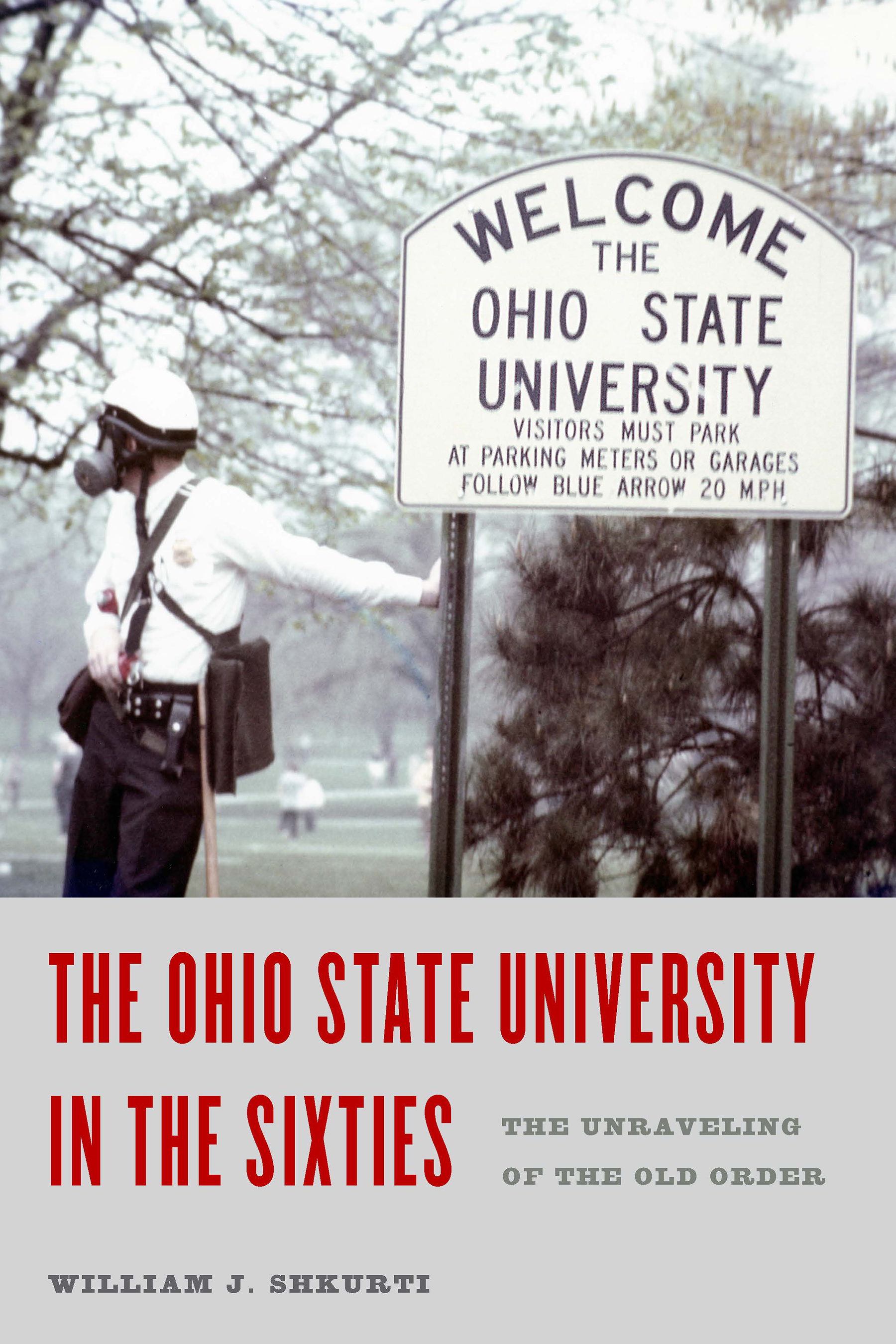“This is the best account of OSU in the 1960s that I’ve ever seen. Bill Shkurti has presented a thorough account of the issues and events of the period. These were controversial times, and this book respects different points of view. Particularly noteworthy is the use of the student newspaper, the Lantern, to shed light on the student perspective. His experiences as a former student and later as a vice president has enabled him to present a very balanced and accurate work. . . Check the pictures. You may see someone you know!”—Raimund E. Goerler, author of The Ohio State University: An Illustrated History (OSUP)
At 5:30 p.m. on May 6, 1970, an embattled Ohio State University President Novice G. Fawcett took the unprecendented step of closing down the university. Despite the presence of more than 1,500 armed highway patrol officers, Ohio National Guardsmen, deputy sheriffs, and Columbus city police, university and state officials feared they could not maintain order in the face of growing student protests. Students, faculty, and staff were ordered to leave; administrative offices, classrooms, and laboratories were closed. The campus was sealed off. Never in the first one hundrred years of the university’s existence had such a drastic step been necessary.
Just a year earlier the campus seemed immune to such disruptions. President Nixon considered it safe enough to plan an address at commencement. Yet a lear later the campus erupted into a spasm of violent protest exceeding even that of traditional hot spots like Berkeley and Wisconsin. How could conditions have changed so dramatically in just a few short months?
Using contemporary news stories, long overlooked archival materials, and first-person interviews, The Ohio State University in the Sixties explores how these tensions built up over years, why they converged when they did, and how they forever changed the university.
 William J. Shkurti is retired from The Ohio State University. His most recent positions have been Senior Vice President for Business and Finance from 2000 to 2010 and Vice President for Finance from 1990 to 2000. He was also an undergraduate at OSU from 1964 to 1968. Currently, Bill is an adjunct professor at the John Glenn College of Public Affairs.
William J. Shkurti is retired from The Ohio State University. His most recent positions have been Senior Vice President for Business and Finance from 2000 to 2010 and Vice President for Finance from 1990 to 2000. He was also an undergraduate at OSU from 1964 to 1968. Currently, Bill is an adjunct professor at the John Glenn College of Public Affairs.
Prologue Ohio State in the Fifties
1 New Frontiers (1960–61)
2 Going Nuclear (1961–62)
3 In Dreams (1962–63)
4 Winds of Change (1963–64)
5 Boomer Invasion (1964–65)
6 The End of the Speakers Rule (1965)
7 Soaring (1965–66)
8 The Beat Goes On (1966–67)
9 Down the Rabbit Hole (1967–68)
10 Come Together (1968–69)
11 Road to Armageddon (1969–70)
12 Centennial Chaos (April–August 1970)
Epilogue Living with the Sixties
Conclusion Life in the Middle of the Road
Notes
Bibliographic Note
The Sixties at OSU in Photos
OSU Lantern and Makio photographers left a legacy of thousands of images of campus events from this eventful decade. Only a small portion of them could be reproduced in the hard copy edition of OSU in the Sixties due to cost. But thanks to the wonders of digital technology, we were able reproduce more than 150 of the most interesting of them on this web site. They are organized by school year, just like in the print edition.
I’d like to thank the OSU Archives for making these photos available in an electronic format. You can find digitized Lanterns at digital.olivesoftware.com/Olive/APA/Ohio and Makios at edu.arcasearch.com/usohosy. We have tried to identify the people in these photos whenever possible. If you recognize someone not identified, let us know at shkurti.1@osu.edu, and we will include that information to complete this photographic record.
Bill Shkurti

Cover. Strike! Students support the Ad Hoc Coalition protest at a spring 1970 Oval rally. (Makio, 1970, 176)
Chapter 1: New Frontiers (1960–61)
 P.1. New freshmen in the fall of 1959. This last freshman class of the 1950s was predominately male and white. Only about forty percent were expected to graduate. (Lantern, 9/25/59, 1)
P.1. New freshmen in the fall of 1959. This last freshman class of the 1950s was predominately male and white. Only about forty percent were expected to graduate. (Lantern, 9/25/59, 1)
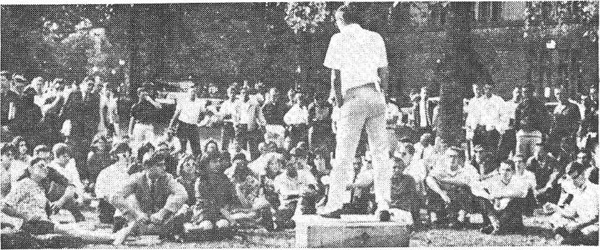 P.2. The Oval served as the campus town square. (Lantern, 10/4/63, 1)
P.2. The Oval served as the campus town square. (Lantern, 10/4/63, 1)
 1.1. Freshman Clarence Anderson does not appear to be overly enthused as he is fitted for his ROTC uniform by SFC Albert Moulaison the first day of classes. (Makio, 1961, 25)
1.1. Freshman Clarence Anderson does not appear to be overly enthused as he is fitted for his ROTC uniform by SFC Albert Moulaison the first day of classes. (Makio, 1961, 25)
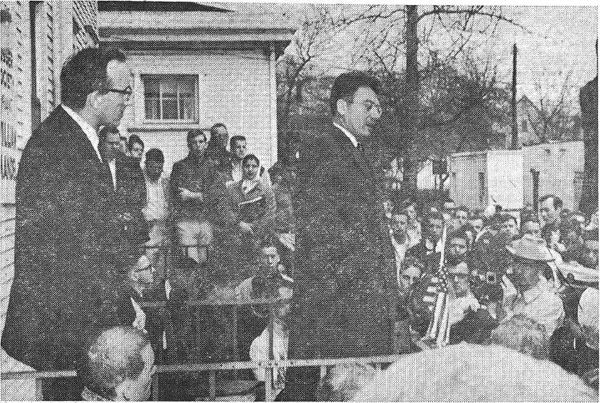 1.2. After being banned from speaking on campus, William Mandel (standing right) addresses a crowd of about two hundred in the backyard of Assistant Professor Henry St. Onge (left) at 65 E. Woodruff. (Lantern, 4/14/61, 1)
1.2. After being banned from speaking on campus, William Mandel (standing right) addresses a crowd of about two hundred in the backyard of Assistant Professor Henry St. Onge (left) at 65 E. Woodruff. (Lantern, 4/14/61, 1)
 1.3. Council of Student Affairs served as traffic cop and court of last resort for student life issues. Note in this case, women are well represented. Top row: Larry Katz (student), Dean Conaway, Dr. Burnett (faculty), Bill Fields (student), Cora Riber (student), Dean Ross, Myron Belkind (Lantern editor). Front row: Roger Harold, Dean Scott, Dean Guthrie, Mary Zaina (WSGA), Robert Young (Student Senate president), Susan Meyer (student). (Makio, 1961, 203)
1.3. Council of Student Affairs served as traffic cop and court of last resort for student life issues. Note in this case, women are well represented. Top row: Larry Katz (student), Dean Conaway, Dr. Burnett (faculty), Bill Fields (student), Cora Riber (student), Dean Ross, Myron Belkind (Lantern editor). Front row: Roger Harold, Dean Scott, Dean Guthrie, Mary Zaina (WSGA), Robert Young (Student Senate president), Susan Meyer (student). (Makio, 1961, 203)
 1.4. The Student Senate was the principal forum for activist students to advance their agendas at the beginning of the decade. Here, law student Benson Wolman, who would go on to become head of the Ohio ACLU, argues a point. (Makio, 1961, 209)
1.4. The Student Senate was the principal forum for activist students to advance their agendas at the beginning of the decade. Here, law student Benson Wolman, who would go on to become head of the Ohio ACLU, argues a point. (Makio, 1961, 209)
 1.5. While the Student Senate provided a forum for student activists, the Lantern often served as catalyst for campus issues. Here, Lantern business manager Paul Burks tracks ads. Familiar names include Turntable Records, Pizza City, and the Blue Danube Restaurant. (Makio, 1961, 213)
1.5. While the Student Senate provided a forum for student activists, the Lantern often served as catalyst for campus issues. Here, Lantern business manager Paul Burks tracks ads. Familiar names include Turntable Records, Pizza City, and the Blue Danube Restaurant. (Makio, 1961, 213)
 1.6. OSU into space—researchers Ronald Long and Robert Taylor inspect an antenna and transmitter-receiver they designed to be hurled into space in the nose cone of an Atlas rocket. (Makio, 1961, 128)
1.6. OSU into space—researchers Ronald Long and Robert Taylor inspect an antenna and transmitter-receiver they designed to be hurled into space in the nose cone of an Atlas rocket. (Makio, 1961, 128)
 1.7. Space psychology—researchers in the OSU Aviation Psychology Lab study group decision making to help prepare astronauts for travel in space. (Makio, 1961, 134)
1.7. Space psychology—researchers in the OSU Aviation Psychology Lab study group decision making to help prepare astronauts for travel in space. (Makio, 1961, 134)
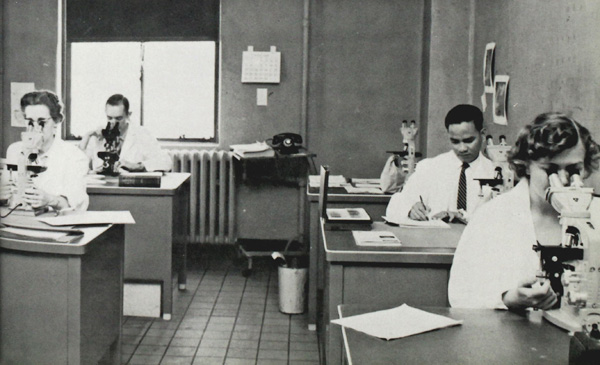 1.8. High-tech cancer research 1960 style—cytotechnologists at the OSU cancer research facility examine cell samples. (Makio, 1961, 135)
1.8. High-tech cancer research 1960 style—cytotechnologists at the OSU cancer research facility examine cell samples. (Makio, 1961, 135)

1.9. Democratic vice presidential candidate, Senator Lyndon B. Johnson, speaks at a Kennedy campaign rally in front of the Ohio Historical Society Museum (now Sullivant Hall) on September 30, 1960. He urged students to become more involved in politics. Ironically, they would and help drive him from office in 1968. (Makio, 1961, 70)

1.10. Coach Woody Hayes shows his support for the presidential campaign of Vice President Richard Nixon at an October 27 Statehouse rally. Note Nixon-Lodge button on Woody’s Coat. (Makio, 1961, 72)
 1.11. Free at last!—graduation day. Note stylish cat’s eye sunglasses on female student. (Makio, 1961, 125)
1.11. Free at last!—graduation day. Note stylish cat’s eye sunglasses on female student. (Makio, 1961, 125)
Chapter 2: Going Nuclear (1961–62)
 2.1. Members of Sigma Nu fraternity show their displeasure with the Rose Bowl decision by hanging effigies of the twenty-eight members of Faculty Council who voted not to go to the Rose Bowl. (Makio, 1962, 238)
2.1. Members of Sigma Nu fraternity show their displeasure with the Rose Bowl decision by hanging effigies of the twenty-eight members of Faculty Council who voted not to go to the Rose Bowl. (Makio, 1962, 238)
 2.2. Students sit down at the intersection of Broad and High Street in Downtown Columbus to protest the Rose Bowl decision. (Makio, 1962, 38)
2.2. Students sit down at the intersection of Broad and High Street in Downtown Columbus to protest the Rose Bowl decision. (Makio, 1962, 38)
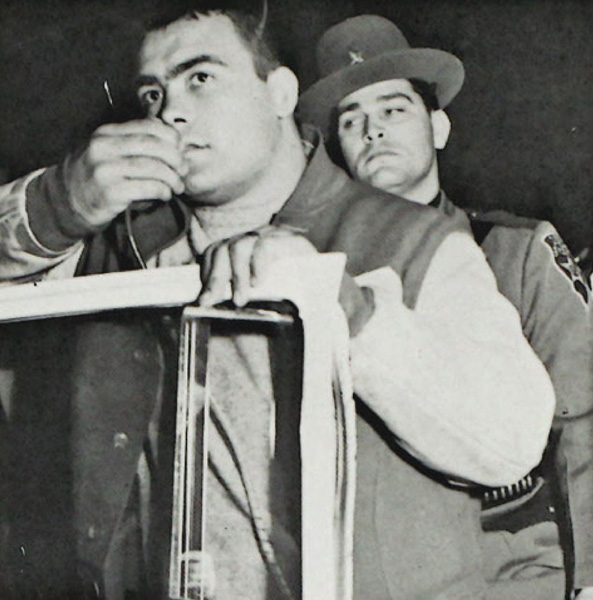 2.3. Football cocaptain Mike Ingram urges protesting students to go home. Most did, effectively ending the bowl protests. (Makio, 1962, 37)
2.3. Football cocaptain Mike Ingram urges protesting students to go home. Most did, effectively ending the bowl protests. (Makio, 1962, 37)

2.4. Two uniformed Columbus police officers guard the door to President Fawcett’s office after Rose Bowl related threats. (Makio, 1962, 38)
 2.5. Student Senate President Phil Moots and WSGA President Mary Kennedy make a joint appearance at the Phi Mu sorority house to encourage student participation in campus governance. (Lantern, 1/30/62, 1)
2.5. Student Senate President Phil Moots and WSGA President Mary Kennedy make a joint appearance at the Phi Mu sorority house to encourage student participation in campus governance. (Lantern, 1/30/62, 1)
 2.6. Jim Gross (left) being congratulated as the first directly elected Student Senate and student body president by his opponent, Niki Schwartz. (Makio, 1962, 60)
2.6. Jim Gross (left) being congratulated as the first directly elected Student Senate and student body president by his opponent, Niki Schwartz. (Makio, 1962, 60)
 2.7. Executive Dean for Student Relations John Bonner. He would have a contentious relationship with many student activists until reassigned to other duties in the summer of 1968. (Makio, 1965, 149)
2.7. Executive Dean for Student Relations John Bonner. He would have a contentious relationship with many student activists until reassigned to other duties in the summer of 1968. (Makio, 1965, 149)
 2.8. Campus Planning Director John Herrick, chief architect of the 1962 Master Plan. (Makio, 1962, 145)
2.8. Campus Planning Director John Herrick, chief architect of the 1962 Master Plan. (Makio, 1962, 145)
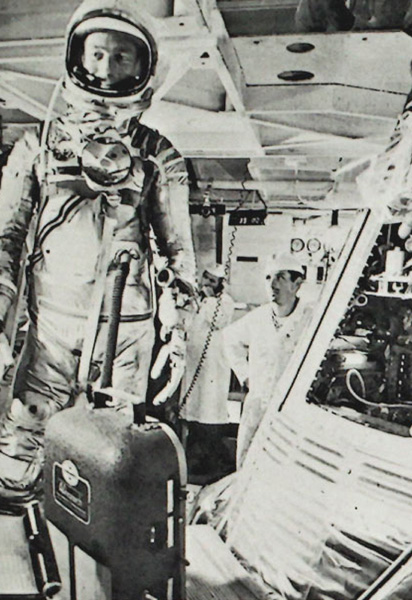
2.9. This space suit worn by Mercury astronaut Scott Carpenter was developed by OSU Scientists. (Makio, 1962, 62)

2.10. Cooling tank for OSU nuclear reactor. Note size of people compared to size of tower. (Makio, 1963, 118)
 2.11. U.S. Senator Barry Goldwater talks with admiring OSU students. Despite shifting political values on campus, he would remain a popular campus draw into the midsixties. (Makio, 1962, 50)
2.11. U.S. Senator Barry Goldwater talks with admiring OSU students. Despite shifting political values on campus, he would remain a popular campus draw into the midsixties. (Makio, 1962, 50)
Chapter 3: In Dreams (1962–63)
 3.1. Students turn out in record numbers to vote against OSU participation in the National Student Association. (Makio, 1963, 31)
3.1. Students turn out in record numbers to vote against OSU participation in the National Student Association. (Makio, 1963, 31)
 3.2. “Had Enough?” One of the Lantern ads that Student Congress Party used to capture the Student Senate in 1963. (Lantern, 2/26/63, 8)
3.2. “Had Enough?” One of the Lantern ads that Student Congress Party used to capture the Student Senate in 1963. (Lantern, 2/26/63, 8)
 3.3. Easter Sunday service in Mirror Lake Hollow, 1963. At that time, almost ninety percent of OSU students declared religious affiliation. (Makio, 1963, 216–217)
3.3. Easter Sunday service in Mirror Lake Hollow, 1963. At that time, almost ninety percent of OSU students declared religious affiliation. (Makio, 1963, 216–217)
 3.4. Language labs like this one proved to be an extremely popular and effective use of technology to let students learn at their own pace. (Makio, 1963, 114)
3.4. Language labs like this one proved to be an extremely popular and effective use of technology to let students learn at their own pace. (Makio, 1963, 114)
 3.5. High-tech 60s style—a student fills his cup with a Coke from a vending machine in his dorm basement for ten cents, or about seventy-six cents at today’s prices. (Makio, 1963, 283)
3.5. High-tech 60s style—a student fills his cup with a Coke from a vending machine in his dorm basement for ten cents, or about seventy-six cents at today’s prices. (Makio, 1963, 283)
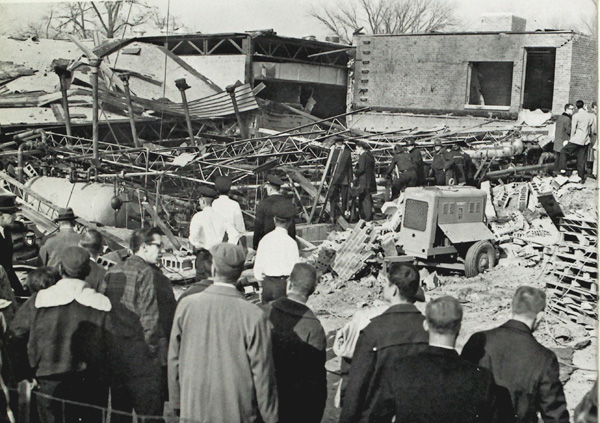 3.6. This gas explosion at the Royer Commons construction site in December 1962 threatened to delay the opening of much-needed housing for incoming students. (Makio, 1963, 38)
3.6. This gas explosion at the Royer Commons construction site in December 1962 threatened to delay the opening of much-needed housing for incoming students. (Makio, 1963, 38)
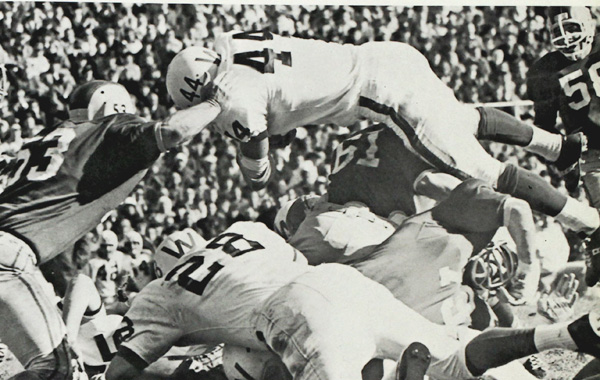 3.7. The show must go on—82,540 fans pack into the Horseshoe to watch OSU upset Wisconsin on the afternoon of October 27 at the same time the Cuban Missile Crisis reached its most harrowing moments. That’s OSU linebacker Bill Armstrong (#53) putting the strong arm on Wisconsin fullback Merritt Nowell (#44). (Makio, 1963, 237)
3.7. The show must go on—82,540 fans pack into the Horseshoe to watch OSU upset Wisconsin on the afternoon of October 27 at the same time the Cuban Missile Crisis reached its most harrowing moments. That’s OSU linebacker Bill Armstrong (#53) putting the strong arm on Wisconsin fullback Merritt Nowell (#44). (Makio, 1963, 237)

3.8. A familiar symbol marks the fallout shelter in the basement of Hughes Hall. Note handwritten note on the bottom which says, “In the event of war this shelter will be useless.” (Lantern, 12/3/62, 1)
Chapter 4: Winds of Change (1963–64)
 4.1. Seeds of rebellion—Royer Commons, pictured here, did survive the December 1962 explosion (see chapter 3) and opened on time in the fall. North Campus residents rebelled when the North Campus Provisional Government tried to impose strict dress rules in this coed cafeteria, igniting a controversy that would end with an eventual repeal of all dress rules. (Makio, 1964, 377)
4.1. Seeds of rebellion—Royer Commons, pictured here, did survive the December 1962 explosion (see chapter 3) and opened on time in the fall. North Campus residents rebelled when the North Campus Provisional Government tried to impose strict dress rules in this coed cafeteria, igniting a controversy that would end with an eventual repeal of all dress rules. (Makio, 1964, 377)
 4.2. Sitting in for civil rights—these OSU students are participating in a sit-in at the offices of Buckeye Management in October 1963 to protest discrimination against black students in that company’s rental properties. This is the first instance of OSU students participating in a sit-in on or near campus. It will not be the last. (Lantern, 10/21/63, 1)
4.2. Sitting in for civil rights—these OSU students are participating in a sit-in at the offices of Buckeye Management in October 1963 to protest discrimination against black students in that company’s rental properties. This is the first instance of OSU students participating in a sit-in on or near campus. It will not be the last. (Lantern, 10/21/63, 1)

4.3. Critics blamed inflammatory Lantern coverage for inciting the so-called 1964 Jaywalking Riot. (Lantern, 2/12/64, 1)
 4.4. Most of the participants in the jaywalking protests just milled around. (Makio, 1964, 71)
4.4. Most of the participants in the jaywalking protests just milled around. (Makio, 1964, 71)
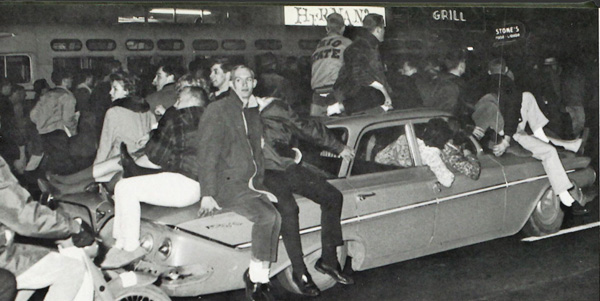 4.5. Others were more active. (Makio, 1964, 72)
4.5. Others were more active. (Makio, 1964, 72)

4.6. Student Senate President Paul Schwitzgebel (center), accompanied by Columbus Police Chief George Scholer (left), urges students to return to campus. (Makio, 1964, 72)
 4.7. Columbus Mayor M. E. Sensenbrenner wore a flag lapel pin long before many other politicians. His conservative views on social issues and his unrelenting boosterism regarding Columbus did not appeal to everyone on campus. (Columbus.gov)
4.7. Columbus Mayor M. E. Sensenbrenner wore a flag lapel pin long before many other politicians. His conservative views on social issues and his unrelenting boosterism regarding Columbus did not appeal to everyone on campus. (Columbus.gov)
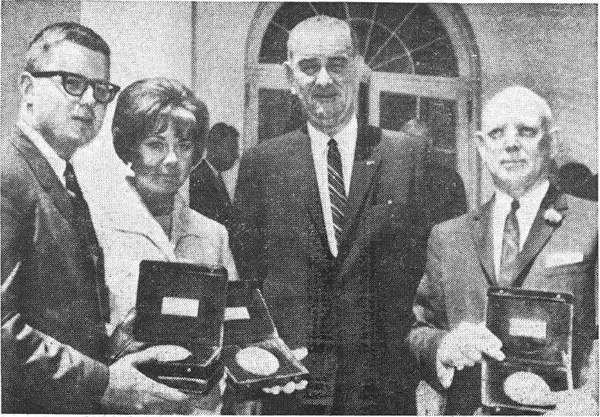 4.8. Lantern reporter Jean Heller received a national journalism award for her coverage of the jaywalking incident and local reaction to the Kennedy assassination. Here she is shown receiving her award from President Johnson at a White House Ceremony in May of 1964. She would go on to be a prize-winning reporter. (Lantern, 5/12/64, 1)
4.8. Lantern reporter Jean Heller received a national journalism award for her coverage of the jaywalking incident and local reaction to the Kennedy assassination. Here she is shown receiving her award from President Johnson at a White House Ceremony in May of 1964. She would go on to be a prize-winning reporter. (Lantern, 5/12/64, 1)
 4.9. Large classes and their impact on undergraduate teaching would remain an issue throughout the 1960s. (Makio, 1963, 97)
4.9. Large classes and their impact on undergraduate teaching would remain an issue throughout the 1960s. (Makio, 1963, 97)
 4.10. Sixties search engine—a card catalog like this filled with 3 x 5 cards formed the heart of every campus library. (Makio, 1964, 104)
4.10. Sixties search engine—a card catalog like this filled with 3 x 5 cards formed the heart of every campus library. (Makio, 1964, 104)

4.11. A dark day in November—this Lantern issue was a rare, extra edition that came out that evening. (Lantern, 11/22/63, 1)
 4.12. The gloomy winter of 1963–64 would finally give way to spring. The campus and the country shook off their doldrums to find their spirits lifted by the music of a talented quartet of four musicians from Liverpool who would help define the sixties. (Makio, 1964, 129)
4.12. The gloomy winter of 1963–64 would finally give way to spring. The campus and the country shook off their doldrums to find their spirits lifted by the music of a talented quartet of four musicians from Liverpool who would help define the sixties. (Makio, 1964, 129)

4.13. Student Senate president candidates, Stan Darling (standing) and Jeff Schwartz, debate at Baker cafeteria. Darling would go on to win the election, but Schwartz would go on to help lead the Free Speech Front. (Makio, 1964, 131)

4.14. Local folksinger, Josh White, leads the faithful in a chorus of “We Shall Overcome” at the May 1964 civil rights rally on the Oval. Most student organizations supported the rally, but only reluctantly because of fears it would be controversial. The civil rights moment would also help define the 60s. (Makio, 1964, 193)
Chapter 5: Boomer Invasion (1964–65)
 5.1. Here they come! Part of the largest freshman class ever shows up for orientation in summer 1964. They would march to a brand new beat. (Lantern, 7/30/64, 8)
5.1. Here they come! Part of the largest freshman class ever shows up for orientation in summer 1964. They would march to a brand new beat. (Lantern, 7/30/64, 8)

5.2. Freshman Dora Bailey of Poland, Ohio is assisted by her father when moving into Norton House on move-in day, September 26. (Lantern, 9/28/64, 4)
 5.3. Tower mania—original concept of the River Towers from a 1961 drawing. These multiple twelve-story all-glass structures devolved into two twenty-four-story cement behemoths by the time they were built in 1965. (Lantern, 11/27/61, 1)
5.3. Tower mania—original concept of the River Towers from a 1961 drawing. These multiple twelve-story all-glass structures devolved into two twenty-four-story cement behemoths by the time they were built in 1965. (Lantern, 11/27/61, 1)
 5.4. Vice President Gordon B. Carson, godfather of the twenty-four-story River Towers. (Lantern, 7/1/71, 1)
5.4. Vice President Gordon B. Carson, godfather of the twenty-four-story River Towers. (Lantern, 7/1/71, 1)
 5.5. Hey, where’s the nearest McDonalds? These four OSU students are obviously pleased to be out of six weeks of confinement after testing space food for the Apollo mission. From left to right are Brooks Harrop, Gerald Peterson, John Kelley, and Norman Gary. (Lantern, 2/24/65, 1)
5.5. Hey, where’s the nearest McDonalds? These four OSU students are obviously pleased to be out of six weeks of confinement after testing space food for the Apollo mission. From left to right are Brooks Harrop, Gerald Peterson, John Kelley, and Norman Gary. (Lantern, 2/24/65, 1)
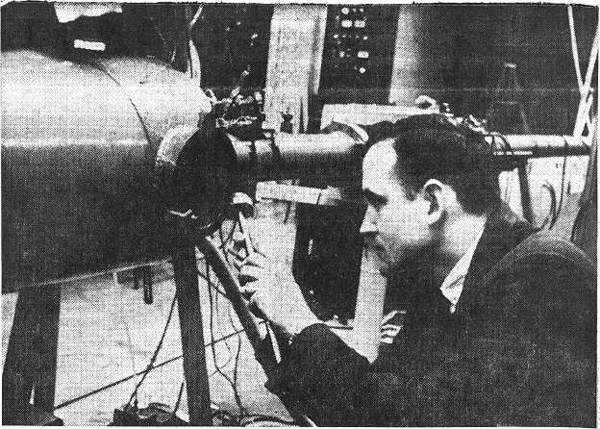 5.6. Shock Tube in OSU Aerodynamics Lab, one of many projects supporting the Apollo mission to the moon. (Lantern, 8/17/65, 8)
5.6. Shock Tube in OSU Aerodynamics Lab, one of many projects supporting the Apollo mission to the moon. (Lantern, 8/17/65, 8)
Chapter 6: The End of the Speakers Rule (1965)

6.1. Anti-Speakers Rule protest, spring 1965. (Makio, 1965, 82–83)

6.2. Part of the crowd at the April 22 Anti-Speakers Rule rally on the Oval. (Lantern, 4/23/65, 1)

6.3. OSU faculty members picket the administration building in protest against the Speakers Rule. Paul Olscamp, assistant professor of philosophy, who will later become president of Bowling Green State University is in the center. The sign he is carrying says “Abolish the Rule” in Latin. (Lantern, 5/13/65, 1)
 6.4. FSF leader Jeff Schwartz counts votes to continue the sit-in protesting against the Speakers Rule. Protest leaders encouraged participants to dress conservatively and clean up after themselves. (Makio, 1965, 86)
6.4. FSF leader Jeff Schwartz counts votes to continue the sit-in protesting against the Speakers Rule. Protest leaders encouraged participants to dress conservatively and clean up after themselves. (Makio, 1965, 86)
 6.5. Participants in the sit-in occupied themselves by reading, playing cards, or playing folk music. (Makio, 1965, 86)
6.5. Participants in the sit-in occupied themselves by reading, playing cards, or playing folk music. (Makio, 1965, 86)
 6.6. FSF leaders leave the second floor of the Administration Building after the sit-in on April 29. They include from left to right Gary Bower (clapping hands), Jeff Schwartz, and Robert Lonzo. (Lantern, 4/30/65, 1)
6.6. FSF leaders leave the second floor of the Administration Building after the sit-in on April 29. They include from left to right Gary Bower (clapping hands), Jeff Schwartz, and Robert Lonzo. (Lantern, 4/30/65, 1)
 6.7. Herbert Aptheker (glasses center) being escorted across campus after his May 6 non-speaking engagement. (Makio, 1965, 87)
6.7. Herbert Aptheker (glasses center) being escorted across campus after his May 6 non-speaking engagement. (Makio, 1965, 87)
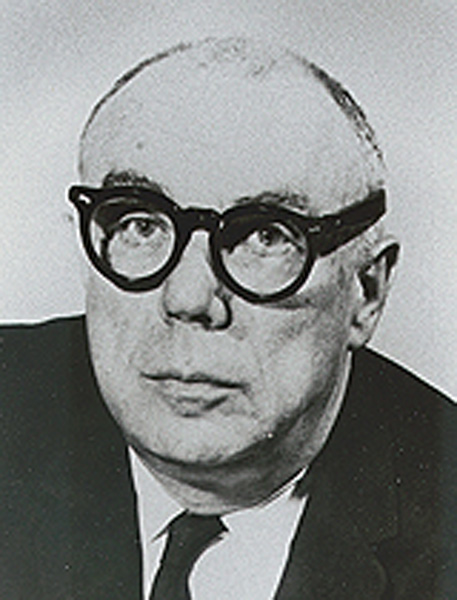
6.8. Newly appointed trustee James Shocknessy cast the deciding vote at the September 1965 board meeting. (ohiohighered.org)
Chapter 7: Soaring (1965–66)

7.1. The university embarked on a construction boom to accommodate growing numbers of students. Here workmen put finishing touches on Drackett Tower. (Makio, 1965, 9)

7.2. This handmade sign informs readers that the Lanterns endorsing the FSF referendum were stolen from loading docks the day before the election. The identity of the perpetrators was never determined. (Lantern, 3/2/66, 1)
 7.3. The gavel of Student Senate president is passed from Tom Workman to Tim Neustadt after a tumultuous year in which the very existence of Student Senate was challenged. (Lantern, 3/4/66, 1)
7.3. The gavel of Student Senate president is passed from Tom Workman to Tim Neustadt after a tumultuous year in which the very existence of Student Senate was challenged. (Lantern, 3/4/66, 1)
 7.4. The first meeting of the constitutional convention on April 30. Convention Chair Allen Malamed is seated at the desk in front. Delegate Maurice Solkov is standing to his right. (Lantern, 5/2/66, 1)
7.4. The first meeting of the constitutional convention on April 30. Convention Chair Allen Malamed is seated at the desk in front. Delegate Maurice Solkov is standing to his right. (Lantern, 5/2/66, 1)
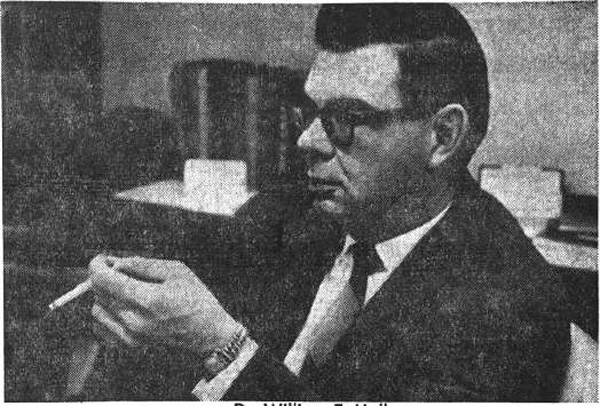 7.5. Shape up or ship out—newly appointed School of Journalism Director William A. Hall ignited a controversy when he suggested existing faculty unhappy with his appointment find employment elsewhere. Things eventually settled down and he served as chair without further controversy for twelve years. (Lantern, 4/15/66, 1)
7.5. Shape up or ship out—newly appointed School of Journalism Director William A. Hall ignited a controversy when he suggested existing faculty unhappy with his appointment find employment elsewhere. Things eventually settled down and he served as chair without further controversy for twelve years. (Lantern, 4/15/66, 1)

7.6. Faces in the crowd—April Oval rally to protest the hiring of William E. Hall as new director of the School of Journalism. (Makio, 1966, 126)
 7.7. John Corbally (left) chats with Dean Bonner on the Oval. Corbally was one of the few administrators trusted both by President Fawcett and most student leaders. Fawcett made him provost in July of 1966. (Lantern, 4/29/65, 8)
7.7. John Corbally (left) chats with Dean Bonner on the Oval. Corbally was one of the few administrators trusted both by President Fawcett and most student leaders. Fawcett made him provost in July of 1966. (Lantern, 4/29/65, 8)
 7.8. Two NAACP pickets lie in front of construction vehicles in May to protest lack of African Americans employed at university construction sites. (Lantern, 5/17/66, 1)
7.8. Two NAACP pickets lie in front of construction vehicles in May to protest lack of African Americans employed at university construction sites. (Lantern, 5/17/66, 1)
 7.9. John Perera at a Vietnam debate at the Sigma Chi fraternity house in May 1966. The twenty-seven-year-old sophomore was one of the original leaders of the campus antiwar movement. Here, he appears to be holding up a cutout map of Vietnam. His debate opponent, James Kellogg, vice president of the campus chapter of Young Americans for Freedom, does not appear to be impressed. (Lantern, 2/4/66, 1)
7.9. John Perera at a Vietnam debate at the Sigma Chi fraternity house in May 1966. The twenty-seven-year-old sophomore was one of the original leaders of the campus antiwar movement. Here, he appears to be holding up a cutout map of Vietnam. His debate opponent, James Kellogg, vice president of the campus chapter of Young Americans for Freedom, does not appear to be impressed. (Lantern, 2/4/66, 1)
 7.10. More than 1,200 students, faculty, and staff donated blood during the November 1965 Vietnam blood drive. (Lantern, 11/11/65, 1)
7.10. More than 1,200 students, faculty, and staff donated blood during the November 1965 Vietnam blood drive. (Lantern, 11/11/65, 1)

7.11. Air Force Captain William J. Barthelmas (class of 1958), the first OSU graduate to lose his life in Vietnam when his F105 fighter-bomber was shot down in July 1965. (Makio, 1958, 502)
Chapter 8: The Beat Goes On (1966–67)
 8.1. Lines, lines, and more lines. Exploding enrollments meant more lines as these students lined up at the Derby Hall bookstore can attest. Note 1960s style cash register. (Lantern, 3/29/66, 1)
8.1. Lines, lines, and more lines. Exploding enrollments meant more lines as these students lined up at the Derby Hall bookstore can attest. Note 1960s style cash register. (Lantern, 3/29/66, 1)

8.2. Changing of the Guard I—Tim Nuestadt presents the gavel to Lloyd Siegel, the first president of the new Undergraduate Student Government. His vice president, Reg Jackson, looks on. This transfer not only represents a new chapter for USG but the end of the Buckeye Political Party and the rise of the new University Party. (Lantern, 5/10/66, 1)
 8.3. Changing of the Guard II—USG replaces the Student Senate. Here, Assemblywoman Carole Ward raises her hand to be recognized. (Makio, 1967, 134)
8.3. Changing of the Guard II—USG replaces the Student Senate. Here, Assemblywoman Carole Ward raises her hand to be recognized. (Makio, 1967, 134)
 8.4. Changing of the Guard III—both Dean of Women Christine Conaway and Dean of Men Mylin Ross stepped down in 1967 after forty-eight years of service to the university. Here, they are presented with honorary memberships in Freshman Senate by Senate President David Waltz (left) and Vice President Roger Oesch. (Lantern, 5/10/66, 1)
8.4. Changing of the Guard III—both Dean of Women Christine Conaway and Dean of Men Mylin Ross stepped down in 1967 after forty-eight years of service to the university. Here, they are presented with honorary memberships in Freshman Senate by Senate President David Waltz (left) and Vice President Roger Oesch. (Lantern, 5/10/66, 1)
 8.5. A familiar sight—time to pick up schedule cards. (Lantern, 1/24/67, 6)
8.5. A familiar sight—time to pick up schedule cards. (Lantern, 1/24/67, 6)
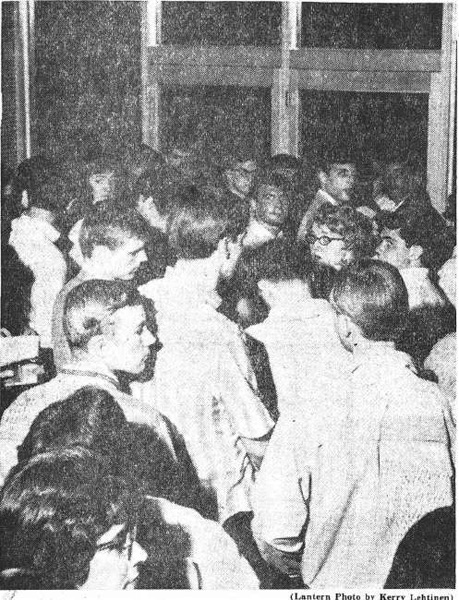
8.6. Another familiar sight—standing in line (in this case, in front of the math building) to change a class schedule. (Lantern, 3/28/67, 1)
 8.7. Traditional values are celebrated at the November 19, 1966 halftime show which honored Medal of Honor recipient LT Charles A. Williams (right). It also featured SSG Barry Sadler (left) singing his popular “Ballad of the Green Berets.” By the end of the school year, traditional values would be increasingly under attack. (Lantern, 11/21/67, 1)
8.7. Traditional values are celebrated at the November 19, 1966 halftime show which honored Medal of Honor recipient LT Charles A. Williams (right). It also featured SSG Barry Sadler (left) singing his popular “Ballad of the Green Berets.” By the end of the school year, traditional values would be increasingly under attack. (Lantern, 11/21/67, 1)

8.8. Traditional values not celebrated—here, protesting students line up to “Shaft the Draft.” (Makio, 1967, 28)

8.9. The annual Corps Day celebration on the Oval becomes a target for antidraft and antiwar protestors. (Makio, 1967, 129)

8.10. Dean Charles Gambs—the former FBI agent is in charge of major disciplinary investigations and becomes a familiar face to campus protestors. (Lantern, 10/29/70, 3)
 8.11. This Lantern ad, paid for by a group of OSU faculty, triggered a lively six-month debate over the direction of the university. (Lantern, 11/18/66, 3)
8.11. This Lantern ad, paid for by a group of OSU faculty, triggered a lively six-month debate over the direction of the university. (Lantern, 11/18/66, 3)

8.12. Governor Rhodes pitches his own plan for greatness, the Ohio Bond Commission, at an Ohio Union press conference. Voters were not persuaded, and the issue failed (Lantern, 4/27/67, 1)

8.13. Dawn of the counterculture—a Lantern ad for Trade Winds, the university area’s first head shop. (Lantern, 3/10/67, 5).
Chapter 9: Down the Rabbit Hole (1967–68)
 9.1. Student protestors hand Provost John Corbally an American flag they took down from the flagpole in front of the Administration Building to protest the assassination of Dr. Martin Luther King. Corbally accepted the flag but ordered it to be put back up at half-mast. (Lantern, 4/8/68, 1)
9.1. Student protestors hand Provost John Corbally an American flag they took down from the flagpole in front of the Administration Building to protest the assassination of Dr. Martin Luther King. Corbally accepted the flag but ordered it to be put back up at half-mast. (Lantern, 4/8/68, 1)

9.2 The 1967–68 schoolyear began with a strike by university maids, janitors and maintenance people that included clashes between students and Columbus police. (1968 Makio, 35)
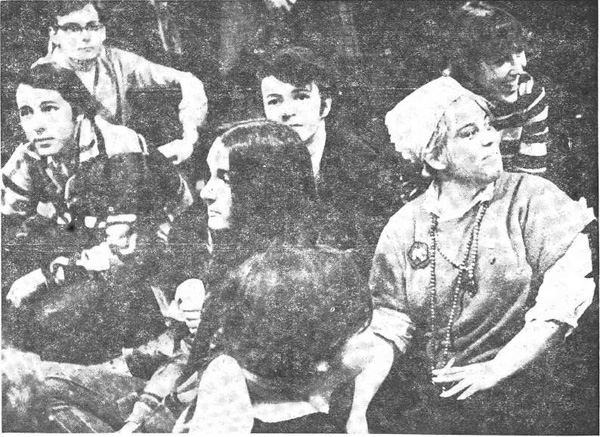 9.3. Autumn Quarter ended with a sit-in against Navy recruiters at the Ohio Union of about sixty protestors. They left peacefully after being threatened with disciplinary action by university officials. (Lantern, 1/3/68, 16)
9.3. Autumn Quarter ended with a sit-in against Navy recruiters at the Ohio Union of about sixty protestors. They left peacefully after being threatened with disciplinary action by university officials. (Lantern, 1/3/68, 16)
 9.4. Winter Quarter began with another sit-in against military recruiters in the main library. Student leaders kept this protest orderly. That’s Dean Bonner standing on the left, trying to keep a clear aisle while protest leader David Travers addresses the crowd. (Lantern, 1/23/68, 1)
9.4. Winter Quarter began with another sit-in against military recruiters in the main library. Student leaders kept this protest orderly. That’s Dean Bonner standing on the left, trying to keep a clear aisle while protest leader David Travers addresses the crowd. (Lantern, 1/23/68, 1)
 9.5. An attempt to block aisles at an anti-recruiting protest at Hamilton Hall at the end of January resulted in the arrest of eleven protestors, including philosophy TA Bern Andersen pictured here. (Lantern, 2/8/68, 1)
9.5. An attempt to block aisles at an anti-recruiting protest at Hamilton Hall at the end of January resulted in the arrest of eleven protestors, including philosophy TA Bern Andersen pictured here. (Lantern, 2/8/68, 1)
 9.6. Five of the so-called Columbus Nine leave the county court house after sentencing in May for their role in the Hamilton Hall protest. Included are Joseph Hyler (left foreground) and Stephen P. Labash (right foreground). Karl F. Braun is behind Hyler. The two men in the back row are William Ganz (left) and Michael Wright. The man in the white shirt and the woman were not identified. (Lantern, 5/16/68, 1)
9.6. Five of the so-called Columbus Nine leave the county court house after sentencing in May for their role in the Hamilton Hall protest. Included are Joseph Hyler (left foreground) and Stephen P. Labash (right foreground). Karl F. Braun is behind Hyler. The two men in the back row are William Ganz (left) and Michael Wright. The man in the white shirt and the woman were not identified. (Lantern, 5/16/68, 1)

9.7. Black Student Union members meet with Dean Bonner in February. That’s John Evans in coat and tie to Bonner's immediate left. (Lantern, 2/2/68, 1)

9.8. The campus mourns the death of Dr. Martin Luther King, April 1968. (Makio, 1968, 186)
 9.9. Protestors voluntarily leave administration building after temporary takeover. While thirty-four black protestors were subsequently charged with kidnapping, white protestors were not disciplined at all, inviting charges of selective enforcement. (Lantern, 4/29/68, 1)
9.9. Protestors voluntarily leave administration building after temporary takeover. While thirty-four black protestors were subsequently charged with kidnapping, white protestors were not disciplined at all, inviting charges of selective enforcement. (Lantern, 4/29/68, 1)
 9.10. OSU Law students march for fair housing, spring 1968. (Lantern, 5/2/68, 1)
9.10. OSU Law students march for fair housing, spring 1968. (Lantern, 5/2/68, 1)

9.11. History Professor David Green lost his job after burning his draft card in class as a protest against violence the day after Martin Luther King was assassinated. (Lantern, 7/12/68, 1)

9.12. Amid the turmoil of the spring of 1968, Jay Shaffer is elected USG president, solidifying University Party’s hold on the Undergraduate Student Government. (Makio, 1969, 135)
 9.13. John Mount (center) flanked by trustees, Marvin France (left) and John Bricker (right), replaced John Bonner as vice president for student affairs after the spring of 1968. (Lantern, 5/1/68, 1)
9.13. John Mount (center) flanked by trustees, Marvin France (left) and John Bricker (right), replaced John Bonner as vice president for student affairs after the spring of 1968. (Lantern, 5/1/68, 1)
 9.14. Using a surplus Ohio National Guard helicopters much like this one, the OSU Medical Center was a national leader in developing today’s medical evacuation system. (Lantern, 5/22/68, 5)
9.14. Using a surplus Ohio National Guard helicopters much like this one, the OSU Medical Center was a national leader in developing today’s medical evacuation system. (Lantern, 5/22/68, 5)

9.15. Comedian-activist Dick Gregory both entertains and challenges a full house at Mershon Auditorium in January. (Makio, 1968, 148)
 9.16. Political Science Professor John Champlin addresses an overflow crowd at Denney Hall at the kickoff meeting of Students for RFK in March 1968. (Lantern, 3/29/68, 1)
9.16. Political Science Professor John Champlin addresses an overflow crowd at Denney Hall at the kickoff meeting of Students for RFK in March 1968. (Lantern, 3/29/68, 1)
 9.17. Actor Paul Newman came to the OSU campus in April to stump for Gene McCarthy. Note eager fans plastered against the doors of Mershon Auditorium. (Makio, 1968, 203)
9.17. Actor Paul Newman came to the OSU campus in April to stump for Gene McCarthy. Note eager fans plastered against the doors of Mershon Auditorium. (Makio, 1968, 203)
Chapter 10: Come Together (1968–69)
 10.1. The championship football season proved to be a unifying force after a difficult year. Here, fullback Jim Otis (#35) flies over the USC line in the Rose Bowl, assisted by a block from tackle Dave Foley (#70), after a handoff from quarterback Rex Kern (#10). (Makio, 1969, 70)
10.1. The championship football season proved to be a unifying force after a difficult year. Here, fullback Jim Otis (#35) flies over the USC line in the Rose Bowl, assisted by a block from tackle Dave Foley (#70), after a handoff from quarterback Rex Kern (#10). (Makio, 1969, 70)
 10.2. We’re #1! These students joined thousands more in celebrating the win over Michigan in November that sent an undefeated OSU team to the Rose Bowl. (Makio, 1969, 56)
10.2. We’re #1! These students joined thousands more in celebrating the win over Michigan in November that sent an undefeated OSU team to the Rose Bowl. (Makio, 1969, 56)

10.3. Lantern ad for a Rose Bowl package. The $185 price tag is equivalent to about $700 in 2016 prices. (Lantern, 12/9/68, 9)
 10.4. SDS marchers, William Ganz (left, Arts-2) and Robert Barcus (Arts-4), help carry a black coffin symbolizing “The Death of the Two Major Parties” across the Oval on November 5, 1968. Ganz and Marcus lost their student deferments for their efforts, an action that was later declared illegal by the U.S. Supreme Court. (Lantern, 11/6/68, 3)
10.4. SDS marchers, William Ganz (left, Arts-2) and Robert Barcus (Arts-4), help carry a black coffin symbolizing “The Death of the Two Major Parties” across the Oval on November 5, 1968. Ganz and Marcus lost their student deferments for their efforts, an action that was later declared illegal by the U.S. Supreme Court. (Lantern, 11/6/68, 3)
 10.5. SDS flier for the May 1969 anti-ROTC rally. (University Archives)
10.5. SDS flier for the May 1969 anti-ROTC rally. (University Archives)
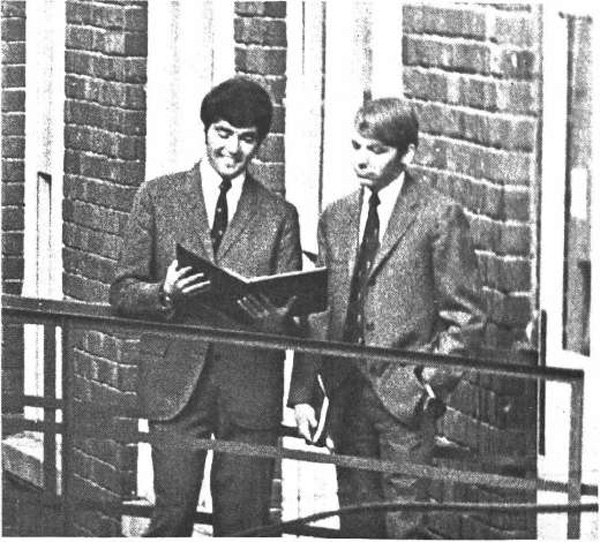 10.6. USG president-elect, Time Sheeran, and running mate, Bruce Achenbach, review their platform. Despite rising student discontent, USG’s influence would be limited by low student participation. (Lantern, 3/5/69, 1)
10.6. USG president-elect, Time Sheeran, and running mate, Bruce Achenbach, review their platform. Despite rising student discontent, USG’s influence would be limited by low student participation. (Lantern, 3/5/69, 1)
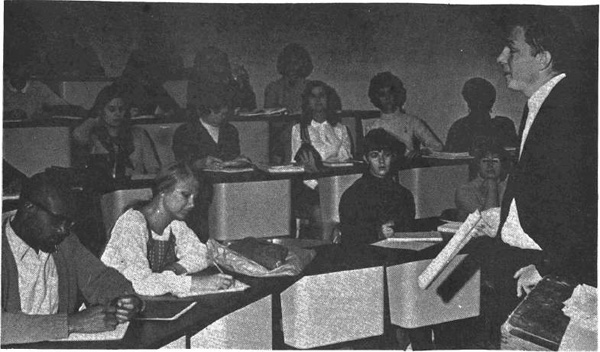 10.7. Ninety students signed up for Assistant Professor Donald Noel’s sociology course on “Black Americans and White Racism” in fall of 1968. (Lantern, 11/18/68, 7)
10.7. Ninety students signed up for Assistant Professor Donald Noel’s sociology course on “Black Americans and White Racism” in fall of 1968. (Lantern, 11/18/68, 7)

10.8. Black is beautiful—a fashion show as part of Black History Week at OSU. (Makio, 1969, 170)
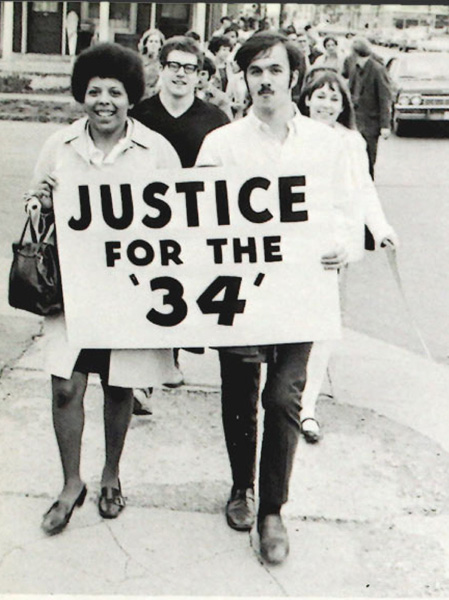
10.9. One of several protests against felony charges filed against members of the Black Student Union for the 1968 administration building takeover. The person on the right holding the sign appears to be law student Mike Schwarzwalder who would go on to serve two terms in the Ohio Senate. The cases were eventually settled on lesser charges but left the University’s relationship with the black community in shambles. (Makio, 1969, 206)
 10.10. Members of OSU’s first all-woman expedition to Antarctica at McMurdo Sound. They include, from left to right, Kay Lindsay; Dr. Lois M. Jones, team leader; Eileen McSaveney; and Terry Tickhill. (Lantern, 11/11/69, 1)
10.10. Members of OSU’s first all-woman expedition to Antarctica at McMurdo Sound. They include, from left to right, Kay Lindsay; Dr. Lois M. Jones, team leader; Eileen McSaveney; and Terry Tickhill. (Lantern, 11/11/69, 1)
 10.11. Dr. Sarah Nunelley, one of five resident graduate students in space medicine at Ohio State and the world’s first woman resident in space medicine. (Lantern, 5/29/69, 5)
10.11. Dr. Sarah Nunelley, one of five resident graduate students in space medicine at Ohio State and the world’s first woman resident in space medicine. (Lantern, 5/29/69, 5)

10.12. James L. Robinson succeeded John Corbally as chief academic officer in July 1969. (Lantern, 7/31/69, 1)

10.13. Ned Q. Moulton, who President Fawcett appointed to the newly created position of vice president for administrative operations in July 1969. (ohiohighered.org)
 10.14. Rock ’em sock ’em—Woody Hayes and candidate Nixon at an October 1968 campaign rally at the statehouse. (Lantern, 10/23/68, 1)
10.14. Rock ’em sock ’em—Woody Hayes and candidate Nixon at an October 1968 campaign rally at the statehouse. (Lantern, 10/23/68, 1)
 10.15. TBDBITL—The OSU Marching Band in President Nixon’s January 1969 inaugural parade. (Lantern, 1/22/69, 5)
10.15. TBDBITL—The OSU Marching Band in President Nixon’s January 1969 inaugural parade. (Lantern, 1/22/69, 5)

10.16. Columbus Mayor M. E. Sensenbrenner displays his Buckeye creds. He is assisted by Ohio Union Activities Public Relations Director Terry Casey. Two years later, OSU students would help end Mayor Sensenbrenner’s political career when eighteen-year-olds voted for the first time. Casey would go on to be a major player in Ohio Republican circles. (Lantern, 11/27/68, 1)
Chapter 11: Road to Armageddon (1969–70)
 11.1. President Fawcett and other dignitaries cut the Centennial Birthday Cake, March 1970. Ironically what they planned as a celebration of the university’s progress turned into a student rebellion against its leadership. (Lantern, 4/1/70, 5)
11.1. President Fawcett and other dignitaries cut the Centennial Birthday Cake, March 1970. Ironically what they planned as a celebration of the university’s progress turned into a student rebellion against its leadership. (Lantern, 4/1/70, 5)
 11.2. This peace vigil in front of the Administration Building on October 15 was part of a national protest that marked the largest ever against the Vietnam War up to that time. The person standing to the left of the protestor holding the vigil sign is reading a list of the more than 2,000 Ohioans killed in the Vietnam War. Organizers promised an even bigger protest for November. (Makio, 1970, 25)
11.2. This peace vigil in front of the Administration Building on October 15 was part of a national protest that marked the largest ever against the Vietnam War up to that time. The person standing to the left of the protestor holding the vigil sign is reading a list of the more than 2,000 Ohioans killed in the Vietnam War. Organizers promised an even bigger protest for November. (Makio, 1970, 25)
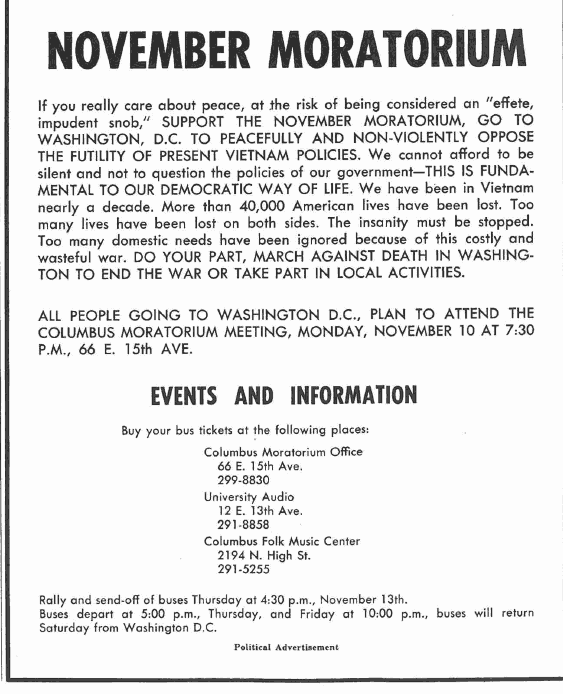
11.3. This Lantern ad is typical of advertisements placed by organizers to generate support across the country for the November 15 “March Against Death” in Washington DC. (Lantern, 11/10/69, 7)

11.4. More protests—members of Afro Am lay bricks in front of the adminstration building on March 13 to symbolize the wall between administration and students. (Makio, 1970, 171)
 11.5. Jerry Roberts (left) and Edward Boston, two leaders of Afro Am, were brought up on charges for violating the Disruption Rule for letting other students into the Administration Building. (Lantern, 9/30/70, 4C)
11.5. Jerry Roberts (left) and Edward Boston, two leaders of Afro Am, were brought up on charges for violating the Disruption Rule for letting other students into the Administration Building. (Lantern, 9/30/70, 4C)

11.6. William E. Conley, John Mount’s special assistant for minority affairs, was OSU’s first black senior administrator. His untimely departure in the spring of 1970 left a void at a critical time. (Makio, 1969, 74)

11.7. One of five students arrested for allegedly disrupting Prospectus ’70 job fair at the Ohio Union on April 21. These arrests and the disciplinary action taken against Afro Am would galvanize efforts for a campus-wide strike for April 29. (Makio, 1970, 175)
 11.8. Meanwhile student government leaders across Ohio supported this April 20 march to the statehouse to protest lack of state support for higher education. Leading the procession from left to right are OSU students Alan Melamed, L. Lee Walker, Steve Kling, and Tim Sheeran. Note all the march leaders are dressed in business attire. The march was peaceful and orderly but had no discernable impact on state officials. (Lantern, 4/20/70, 1)
11.8. Meanwhile student government leaders across Ohio supported this April 20 march to the statehouse to protest lack of state support for higher education. Leading the procession from left to right are OSU students Alan Melamed, L. Lee Walker, Steve Kling, and Tim Sheeran. Note all the march leaders are dressed in business attire. The march was peaceful and orderly but had no discernable impact on state officials. (Lantern, 4/20/70, 1)

11.9. Governor Rhodes stresses the importance of jobs as he talks to chilled students in Mirror Lake Hollow on the morning of the first Earth Day, April 22, 1970. Less than two weeks later he would send the National Guard to Kent State with tragic consequences. (Lantern, 4/23/70, 1)
Chapter 12: Centennial Chaos (April–August 1970)
 12.1. It began with a relatively small group of protestors blocking the street at Neil and 11th on the afternoon of April 29. Note the gate is already closed. (Makio, 1970, 180)
12.1. It began with a relatively small group of protestors blocking the street at Neil and 11th on the afternoon of April 29. Note the gate is already closed. (Makio, 1970, 180)
 12.2. The crowd at Neil and 11th grows quickly. Dan Bradley (Arts-2) in the foreground encourages them to stay together. (Lantern, 9/20/70, 3C)
12.2. The crowd at Neil and 11th grows quickly. Dan Bradley (Arts-2) in the foreground encourages them to stay together. (Lantern, 9/20/70, 3C)
 12.3. Attempts by plainclothes officers to clear the streets spark individual confrontations. (Makio, 1970, 180)
12.3. Attempts by plainclothes officers to clear the streets spark individual confrontations. (Makio, 1970, 180)
 12.4. The ruckus attracts both a growing crowd of spectators and the Ohio Highway Patrol, who eye each other uneasily. Note individual with beard and sunglasses, brandishing what appears to be a wooden paddle. (Lantern, 4/30/70, 3)
12.4. The ruckus attracts both a growing crowd of spectators and the Ohio Highway Patrol, who eye each other uneasily. Note individual with beard and sunglasses, brandishing what appears to be a wooden paddle. (Lantern, 4/30/70, 3)
 12.5. Unable to control the crowd, the highway patrol calls for backup. Riot-equipped Columbus Police arrive and drive the crowd away from Neil and 11th towards the Oval. (Makio, 1970, 182)
12.5. Unable to control the crowd, the highway patrol calls for backup. Riot-equipped Columbus Police arrive and drive the crowd away from Neil and 11th towards the Oval. (Makio, 1970, 182)
 12.6. Confrontations go on into the night. The caption to this photo says the police, who are brandishing fixed bayonets, are preparing to rescue an injured patrolman who has fallen into the hands of a group of protestors. (Lantern, 4/30/70, 1)
12.6. Confrontations go on into the night. The caption to this photo says the police, who are brandishing fixed bayonets, are preparing to rescue an injured patrolman who has fallen into the hands of a group of protestors. (Lantern, 4/30/70, 1)
 12.7. As confrontations continue, university officials ask Governor Rhodes for assistance from the Ohio National Guard. The guard helps clear High Street in the evening, then attempts to clear the Oval the next morning. (Lantern, 5/1/70, 1)
12.7. As confrontations continue, university officials ask Governor Rhodes for assistance from the Ohio National Guard. The guard helps clear High Street in the evening, then attempts to clear the Oval the next morning. (Lantern, 5/1/70, 1)

12.8. Tear gas becomes the weapon of choice but with mixed results. (Makio, 1970, 184)
 12.9. This sets off another round of confrontations. (Lantern, 5/19/70, 11)
12.9. This sets off another round of confrontations. (Lantern, 5/19/70, 11)
 12.10. This protestor takes a different approach. (Lantern, 5/1/70, 2)
12.10. This protestor takes a different approach. (Lantern, 5/1/70, 2)
 12.11. A student weaves his way through striking students at Brown Hall. Initially strikers made no attempt to physically interfere. (Makio, 1970, 176)
12.11. A student weaves his way through striking students at Brown Hall. Initially strikers made no attempt to physically interfere. (Makio, 1970, 176)
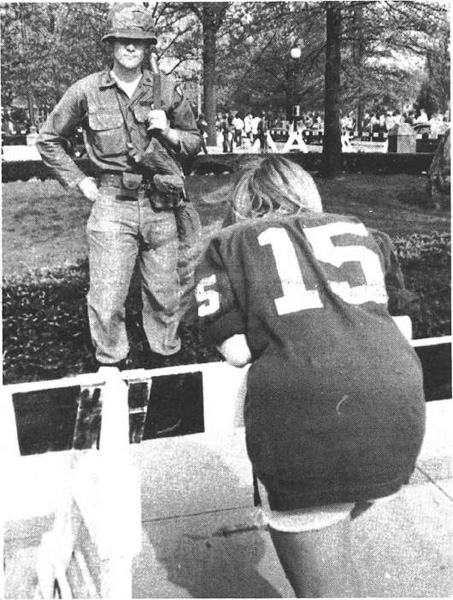
12.12. By the weekend things appear to have calmed down somewhat. Here Kay Lenhart (UVC-1) looks across a barricade on May 3 at her brother, John, who is a member of the Ohio National Guard contingent sent to OSU. (Lantern, 5/4/70, 1)
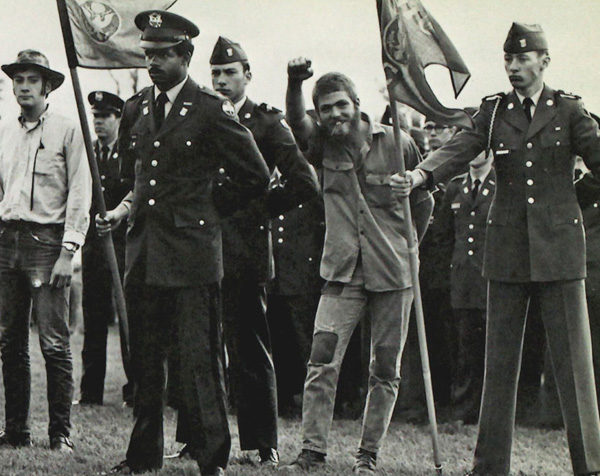 12.13. Protestors and ROTC cadets intermingled on the afternoon of Monday, May 4 right after the Kent State shootings. Fortunately, cooler heads prevailed, and there were no physical confrontations. (Makio, 1970, 190)
12.13. Protestors and ROTC cadets intermingled on the afternoon of Monday, May 4 right after the Kent State shootings. Fortunately, cooler heads prevailed, and there were no physical confrontations. (Makio, 1970, 190)
 12.14. Nevertheless tensions on campus soared after word of the killing of four students at Kent State by Ohio National Guardsmen at noon on May 4. (Makio, 1970, 192)
12.14. Nevertheless tensions on campus soared after word of the killing of four students at Kent State by Ohio National Guardsmen at noon on May 4. (Makio, 1970, 192)
 12.15. On May 6, President Fawcett announced the OSU campus closed until further notice. (Makio, 1970, 196)
12.15. On May 6, President Fawcett announced the OSU campus closed until further notice. (Makio, 1970, 196)

12.16. ID please—the campus reopened on May 17 under tight security. Here students show IDs at a National Guard checkpoint. Note the checker is equipped with a rifle, bayonet, gas mask, sunglasses, and a helmet two sizes too big. While he carefully checks the ID of the woman in a miniskirt, the young man to his left waves his ID without so much as a return glance. (Makio, 1970, 206)
 12.17. “Cool It” ad from the Majority Alliance. (Lantern, 5/19/70, 5)
12.17. “Cool It” ad from the Majority Alliance. (Lantern, 5/19/70, 5)
 12.18. Mass rallies on the Oval were the order of the day. Steve Kling, undergraduate student body president, urges the audience to keep the university open at an Oval rally on May 21. (Lantern, 5/22/70, 14)
12.18. Mass rallies on the Oval were the order of the day. Steve Kling, undergraduate student body president, urges the audience to keep the university open at an Oval rally on May 21. (Lantern, 5/22/70, 14)
 12.19. While the mass rallies were peaceful, some protestors sought confrontation afterwards. This group tries to block the entrances to Hagerty Hall after the May 21 rally. (Lantern, 5/22/70, 10)
12.19. While the mass rallies were peaceful, some protestors sought confrontation afterwards. This group tries to block the entrances to Hagerty Hall after the May 21 rally. (Lantern, 5/22/70, 10)

12.20. Other students tried to block the protestors. Senior Robert Truzzano and friend join half a dozen others, protecting the flag in front of the administration building. (Makio, 1970, 204)

12.21. Strike leaders searched for ways to draw crowds to keep pressure on the administration while staying nonviolent. Graduate students Bill Crandell and Joel Ann Todd, who became increasingly visible as strike leaders once classes resumed in mid-May, are shown here leading the “Where’s Fawcett?” march on May 27. (Makio, 1970, 204)
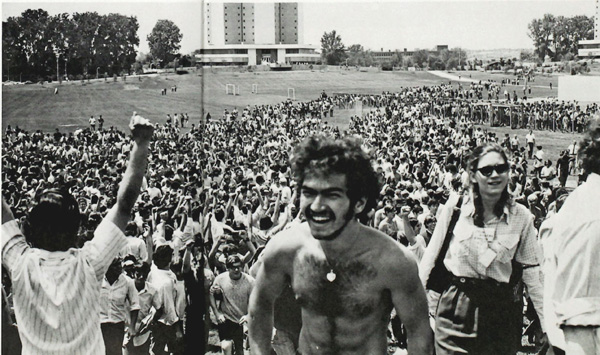 12.22. The “Where’s Fawcett?” march turned out to be a PR success, attracting a large but fairly benign crowd as it traveled across the campus. (Makio, 1970, 204)
12.22. The “Where’s Fawcett?” march turned out to be a PR success, attracting a large but fairly benign crowd as it traveled across the campus. (Makio, 1970, 204)

12.23. More guerilla theater—strike leaders sponsored a student “grovel-in” on May 28 to protest unresponsiveness on the part of the university administration. (Makio, 1970, 204)
 12.24. An anti-ROTC march on June 1 turned out to be not so benign, as protestors and ROTC cadets scuffled at the entrance to the ROTC building. Six students were subsequently arrested for their role in the confrontation which left tires slashed and antennas broken on cars in a nearby parking lot. (Makio, 1970, 190)
12.24. An anti-ROTC march on June 1 turned out to be not so benign, as protestors and ROTC cadets scuffled at the entrance to the ROTC building. Six students were subsequently arrested for their role in the confrontation which left tires slashed and antennas broken on cars in a nearby parking lot. (Makio, 1970, 190)

12.25. Had enough? After weeks of tension, Spring Quarter mercifully came to an end, not with a bang, but with a whimper, leaving many unresolved issues in its wake. (Makio, 1970, 192)
Epilogue: Living with the Sixties

E.1. These bricks are made for throwin’—students found some changes when classes started in the fall. Workers spent the summer removing bricks from campus sidewalks. (Lantern, 8/20/70, 5)
 E.2. Charles M. Ross, hired as the first director of OSU’s black studies program in July 1970. (Lantern, 7/23/70, 7)
E.2. Charles M. Ross, hired as the first director of OSU’s black studies program in July 1970. (Lantern, 7/23/70, 7)
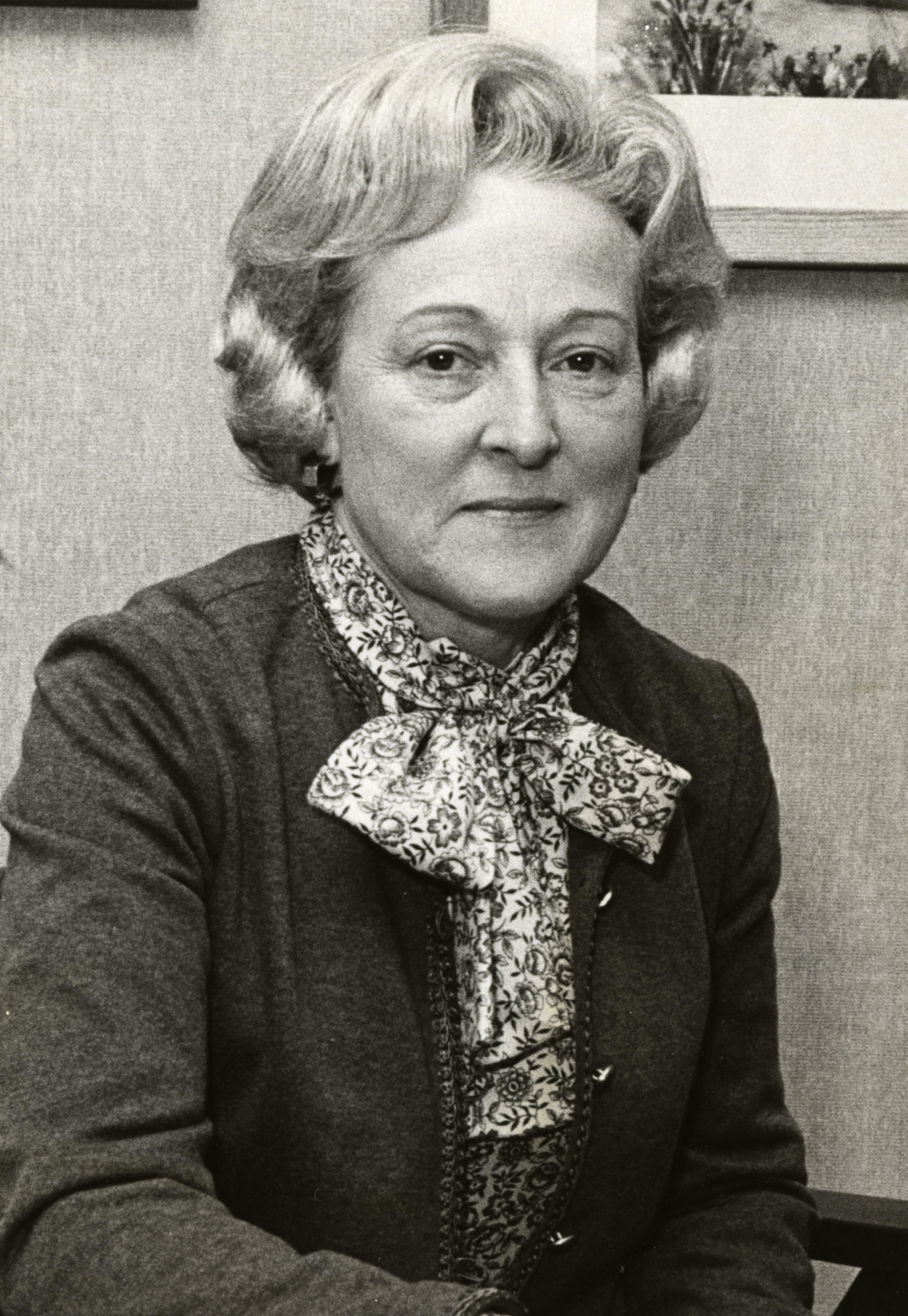 E.3. Kathryn Schoen became the first woman to hold a senior admisntrative position at OSU when she was appointed vice president for educational services in 1978. (Lantern, 9/18/78, 10)
E.3. Kathryn Schoen became the first woman to hold a senior admisntrative position at OSU when she was appointed vice president for educational services in 1978. (Lantern, 9/18/78, 10)
 E.4. Welcome back—a downsized ROTC returns to the Oval for the first time in forty years in 2008. (Lantern, 5/23/08, 1)
E.4. Welcome back—a downsized ROTC returns to the Oval for the first time in forty years in 2008. (Lantern, 5/23/08, 1)
 E.5. Students are people too—Dr. Harold Enarson was hired in 1971 in part because of his reputation for a rapport with students. (OSU Archives photo)
E.5. Students are people too—Dr. Harold Enarson was hired in 1971 in part because of his reputation for a rapport with students. (OSU Archives photo)
 E.6. Since the 1960s, medical research has replaced defense as OSU’s major research focus. (OSU.edu)
E.6. Since the 1960s, medical research has replaced defense as OSU’s major research focus. (OSU.edu)
 E.7. The new OSU emerged more diverse, more student oriented, and more academically accomplished as a result of the reforms of the 1960s. (OSU.edu)
E.7. The new OSU emerged more diverse, more student oriented, and more academically accomplished as a result of the reforms of the 1960s. (OSU.edu)
This section of WOSU's documentary about the history of Columbus's University District, as part of their Columbus Neighborhoods series, provides an excellent mini-history of many of the events covered in the book.
Where Are They Now?
Sixty from the Sixties
One of the questions most frequently asked by readers of OSU in the Sixties is, whatever happened to these people after the sixties ended? Through the wonders of the Internet we have been able to track down many of the major players from this period. They have been divided into four categories: former Student Senate and USG presidents, other student leaders, faculty, and administrators. To preserve the privacy of these individuals, only publicly available information from reputable sources or information provided by those individuals for this purpose is disclosed. Questions regarding additions or corrections should be addressed to shkurti.1@osu.edu.
Former Student Senate and USG Presidents
The years in parentheses refer to the term of office. Prior to the separation of the Council of Graduate Students in 1963, the Student Senate president also served as president of the student body.
Philip R. Moots (1961–62) went on to Harvard Law School. He returned to practice law in Ohio and served as an executive assistant to Ohio Governor John Gilligan from 1972 to 1975. From 1977 to 1981 he was an associate professor of law and Director of the Center for Constitutional Studies at Notre Dame University. He returned to private practice in Ohio where he has specialized in labor and employment law in higher education and other nonprofits ever since. He was named one of the Best Lawyers in America in 2006. Phil is still practicing law with Newhouse, Prophater, Kolman & Hogan in Columbus and is active in university and community affairs.
James H. Gross (1962–63) was the first directly elected Student Senate president. After graduating from OSU, he went on to Harvard Law School. He returned to Columbus to practice corporate law with Vorys, Sater, Seymour & Pease where he was recognized as Corporate Lawyer of the Year and one of the Best Lawyers in America from 2006 to 2012. He also served as City Attorney for the City of Bexley from 1985 to 2007and was active in a number of charitable organizations, including the OSU Alumni Association. He is now retired and living in Bexley.
H. Paul Schwitzgebel (1963–64) received his MBA from the University of Michigan and masters in divinity from Yale Divinity School after graduating from OSU. He returned to his hometown of Canton where he served as a minister to a number of congregations, including the lead minster for the Canton Congregation of the Unitarian Universalist Church. He also taught technology part-time at Stark State Technical College. He came out in 1968 and has been very active in the GLBT community.
Stanton G. Darling II (1964–65) went on to earn a law degree from Georgetown University Law Center. After serving in Washington as a federal judicial clerk and as legal counsel for Maryland Senator Charles McCurdy Mathias Jr., he moved to California where he taught at several law schools, including Santa Clara and Stanford. In 1981 he returned to Columbus to teach at Capital University Law School, specializing in civil procedure, torts, and products liability. A two-volume civil procedure treatise of which he is coauthor became a standard reference work for judges and attorneys across Ohio. He has served on numerous advisory committees and was the primary drafter of the Ohio Product Liability Act. After forty-five years as a full-time law professor, he retired in 2015 and lives in Columbus.
Thomas E. Workman (1965–66) continued on to OSU Law School and then spent almost four years on active duty as a captain in the Army Judge Advocate General’s Corps. He joined the law firm of Bricker & Eckler where he practiced insurance law and served as chief legal counsel for the Association of Ohio Life Insurance Companies. In 1999 he and his wife, Pam, moved to New York City where he became president and chief executive officer of the Life Insurance Council of New York, Inc. In April of 2016 he stepped down after more than sixteen years but still remains active in various professional capacities.
Tim Neustadt (1966–67) helped lead the transition from the Student Senate to the restructured Undergraduate Student Government (USG). After receiving a master’s degree in classics from OSU, he spent three years in the army as a counterintelligence officer. He returned to his hometown of Cleveland and spent the next twenty-five years as a financial planner and manger for Connecticut General Life Insurance, which later became CIGNA. He eventually rose to regional vice president. He then moved to California and worked for Lincoln Financial, who purchased his company. He is now retired, spending time with his family and traveling the world. He remains active in supporting the OSU departments of Greek and Latin, ROTC, and the College of Veterinary Medicine.
The first USG president, Lloyd Siegel (1967–68), went on to work as a reporter for WKYC-TV in Cleveland after graduation. That led to a forty-four-year career at NBC News in Washington and New York. He rose through the ranks to become a Nightly News producer, then executive producer of news specials, and vice president. During that time he covered many of the news events of the last four decades, including Watergate, the Challenger disaster, and various presidential campaigns. Lloyd is now semiretired and living in New York. He is currently an adjunct faculty member of the Columbia University School of Journalism and Montclair State University’s School of Communication and Media.
Jay C. Shaffer (1968–69) graduated from Harvard Law School in 1974. He was then employed by the federal government, serving in the Justice Department’s Antitrust Division and as Deputy General Counsel of the Federal Trade Commission. After retiring from government service in 1997, he became a consultant for the Organization for Economic Cooperation and Development, preparing assessment reports on competition law systems in developing countries. He now lives in Virginia.
Timothy J. Sheeran, who served as USG president (1969–70), graduated from Harvard Law School, then went to practice labor law for the Cleveland law firm of Squire, Sanders & Dempsy where he was recognized as one of the Best Lawyers in America beginning in 2006. He is now retired and living in North Carolina.
Stephen P. Kling served as USG president (1970–71). He went on to earn a law degree from OSU and has practiced law in Annapolis, Maryland, ever since.
Jerry Friedman (1971–72) earned a law degree from OSU and then spent thirteen years working for the state of Ohio, including eight years as legislative aide to State Senator Mike Schwarzwalder of Columbus. In 1991 Jerry began work as legislative representative for the OSU Wexner Medical Center. He was named Associate Vice President for External Relations and Advocacy in 2010. In 2015 he stepped down from that position but continues to be involved in health policy and advocacy on a part-time basis and remains active in community affairs.
Strike leader and USG president Mike White (1972–73) returned to Cleveland after earning a master’s degree in public administration in 1974. After serving on the Cleveland City Council and in the Ohio Senate, he was elected mayor of Cleveland in 1990. He went on to serve three four-year terms (1990–2002). He now runs an alpaca farm and winery in eastern Ohio.
No woman students were elected USG or Student Senate president in the 1960s, but the two elected vice presidents went on to interesting careers. Eileen Roach (1965–66), now Eileen Roach-Smith, spent thirty-four years in the national security field. A graduate of the Royal College of Defense Studies in London, England, she worked in management positions at the CIA, National Security Agency, and National Security Council. Her positions included chief of language training division for the CIA. She has retired from government service and is an associate with Pherson Associates, LLC, a national security consulting firm headquartered in Washington DC.
L. Lee Walker (1970–71) earned a law degree from Capital University and worked for the state of Ohio where she served as head of the Legislative Reference Bureau and then state budget director under Governor Richard Celeste. She came back Ohio State in 1991 to serve as director of public management programs in the John Glenn School and then as university budget director. She is now retired and living in Panama where she and her husband, Jack, run a bed and breakfast.
Other Student Leaders
Strike leader Lorraine Cohen earned a PhD in sociology from CUNY Graduate Center in 1987. She embarked on a career in college teaching and is currently a professor of sociology and Coordinator of the Labor and Community Organization option at LaGuardia Community College in New York, one of the nation’s largest community colleges. In 2004 she was selected by the New York State United Teachers Organization as the recipient of its Higher Education Award.
William F. Crandell was one of the 1970 strike leaders and a founder of the Central Ohio Chapter of Vietnam Veterans Against the War. Bill spent the next forty years advocating for veterans, while also earning a PhD in history from OSU in 1983. His work on behalf of veterans included serving on the staff of the New York State Department of Veterans’ Affairs, director of the New York Vietnam Veterans Memorial and Museum, legislative affairs director for Vietnam Veterans of America, and staff member of the U.S. House Veterans’ Affairs Committee. Bill has published short stories, book reviews, and short stories in national publications and won a Maryland State Arts Council Individual Artist Award in 2004 for his mystery novel, Let’s Say Jack Kennedy Killed the Girl. He returned to Ohio in 2011 after retiring from the Office of the Inspector General of the Veterans Administration.
Len Downie Jr., the Lantern sports editor who covered the Rose Bowl controversy, went to work for the Washington Post, where he served as an intern in the summer of 1964. He worked his way up the executive ladder from reporter to editor and in 1991 succeeded Ben Bradlee as executive editor. During Downie’s seventeen-year tenure, Post staffers won twenty-five Pulitzer prizes. Len is now the Weil Family Professor of Journalism at the Walter Cronkite School of Journalism and Mass Communication at Arizona State University.
Mabel G. Freeman served as president of the Women’s Self Government Association from 1965 to 1966. Mabel went on to earn both a master’s and PhD in education from OSU. Over three decades she led OSU’s successful efforts to recruit and retain top undergraduate students with initiatives like the highly regarded Honors and Scholars Program and the First Year Experience. She is now semiretired and working part-time at Columbus State Community College. She was recognized by OSU for a Distinguished Service Award in 2015.
Lou Heldman covered the 1970 riots as a columnist for the Lantern and spent more than twenty-five years as a journalist, including publisher of the Wichita Eagle and Kansas.com, the state’s largest newspaper and most visited news website. In 2007 he joined the faculty at Wichita State University as the Distinguished Senior Fellow in Media Management and Journalism. He also served as interim director of the university’s center of the Elliot School of Communications. He is now the university’s vice president for strategic communications.
Jean Heller, the Lantern reporter who won a national award for her coverage of the 1964 jaywalking arrest, went to work as a reporter and editor for the Associated Press, New York Newsday, and St Petersburg Times. She was nominated eight times for a Pulitzer Prize and twice was a finalist. In 1972 she broke the story of the Tuskegee Syphilis Study where the U.S. government used poor, black farmers as guinea pigs for forty years. These revelations led to significant changes in how research subjects are treated. She is now the owner of the Visions Group, a Florida-based national marketing and PR firm.
John Huddy was the former Lantern reporter who went under cover for the Columbus Dispatch to do a series on the drug scene on campus that led to a number of arrests. After serving as a columnist and critic for the Miami Herald, he went on to become a network TV producer and won a variety of awards, including two Emmys for editorial writing and on-air commentary. He also authored a book, Storming Las Vegas, about how a Cuban-born Soviet-trained commando staged a series of audacious armored car heists on the Las Vegas strip.
Free-speech activist Dennis C. Knepley, just a few hours short of graduation in 1968, was drafted into the army and served in Vietnam as a medical technician. He returned to OSU and graduated in 1970. Later Dennis started his own business as a self-employed woodworker. He was also one of the leaders of the citizen’s group opposing the tax for the Nationwide Arena. He lives in Columbus.
Alan Melamed chaired the Constitutional Convention, led the fight against the Ohio Bond Commission, and helped lead the Register Here effort in 1971. After graduating from Case Western Reserve Law School, he practiced law in Cleveland for twenty-nine years. In 1999 he founded Melamed Communications, a firm that does political consulting, governmental affairs, and public relations work.
OSU’s first African American homecoming queen, Marlene Owens Rankin, graduated in 1961 with a BA degree in social work. She returned to Chicago to be employed as a social worker for the next seven years, eventually becoming human resources director for The Museum of Science and Industry. In 1990 she left that position to become executive director of the Jesse Owens Foundation. The foundation has provided hundreds of young adults with support for their education. Marlene has retained her ties to the university, being active in alumni affairs. She and her husband, Stuart Rankin, a 1961 OSU graduate, have been married for more than forty years.
John B. Perera was one of the initial organizers of the OSU antiwar movement. A 1971 Lantern story labeled him the “unofficial godfather” of draft counseling. He eventually moved back to Cleveland where he stayed active in social causes until his death in 1998.
Jerry Roberts, one of the leaders of Afro Am and the 1970 strike, changed his name to Ako Kambon after graduating from OSU in 1975. He became Columbus city clerk and also served as the head of the state of Ohio’s Commission on African American Males. He is the founder and president of the Visionary Leaders Institute of Columbus, a national educational consulting firm, which focuses on educational success for minority students.
After graduating from the OSU College of Law, activist Niki Z. Schwartz taught law at the University of Toledo. He moved to Cleveland in 1968 to practice there, specializing in a variety of criminal and civil areas, including mediation. He won numerous awards, including one of the Best Lawyers in America in six different categories. In April 1993 state officials asked Niki to come to the maximum security prison at Lucasville to represent the rioting inmates, who had taken control of half the prison and held nine guards hostage. His work received bipartisan praise for helping to successfully resolve a very tense standoff without any further loss of life. He continues to practice law in Cleveland as the senior partner of Schwartz, Downey & Co.
After graduating from OSU in 1965, FSF leader Jeffrey A. Schwartz went on to earn a master’s degree from Columbia and a law degree from the University of Minnesota. He spent the next ten years working for the federal government as counsel to the House Energy and Environment Committee as well as doing legal work for the Departments of Health, Education, and Welfare and the EPA. While at HEW he co-led Lawyers Against the Vietnam War. After completing federal service, he did consulting for a variety of nonprofit organizations. He also helped lead the effort to enact the National Child Vaccine Act of 1986. In 2005 he founded Kela Associates, which provides consulting and leadership development assistance to nonprofits. He lives in Maryland and is still active in his consulting business and community advocacy.
“Jovial Bob” Stine, the former Sundial editor, left Columbus after graduation for New York to become a writer. He turned out to be an enormously successful one, pioneering the genre of teen horror fiction under the name of R. L. Stine. He has sold over 350 million books worldwide, including the best-selling Goosebumps series.
Joel Ann Todd, one of the 1970 strike leaders, got her expulsion from the university reversed in federal court. She returned to OSU to finish her master’s in political science in 1974. Since then she has been active in environmental issues, especially green buildings and sustainability, and is now an independent consultant living in Maryland. She is a recipient of the 2013 Leadership in LEED award and served as chair of the LEED Steering Committee of the U.S. Green Building Council.
Bruce Vilanch covered arts and entertainment for the Lantern. He moved to Hollywood after graduation where he thrived as an actor, a writer, and an arranger, including winning six Emmys.
Benson A. Wolman, the student who led the effort to encourage the Citizen Journal and the Dispatch to be more balanced in their election coverage, dropped out of OSU Law School the following year. The Bexley native did eventually return to Columbus where he served as director of the Columbus branch of the American Civil Liberties Union for seventeen years. In 1988 he received a law degree from Capital University and went into private practice. He passed away in 2007, survived by his wife and son. Friends said afterwards that Benson was proudest of his role assisting the victims of the 1970 Kent State shootings.
Faculty
Sociology professor Nancy Clatworthy taught the popular Marriage and the Family course. She continued as a member of the OSU faculty until her retirement in 1986. A licensed pilot, award-winning equestrian, and part-time sculptor, she remained active well into her later years.
Often-quoted economics professor Paul G. Craig left OSU in 1970 to take a job as vice president for academic affairs at Florida State University. He returned to OSU in 1972 and spent the next eight years as a professor in the new school of public administration until his retirement in 1980.
Engineering professor Charles A. Csuri began experimenting with computer-generated art in the mid-1960s. By the 1980s he was internationally known as one of the pioneers in computer-generated graphics. His work filled movie and TV screens everywhere. In 2011 he was featured as one of OSU’s twenty-five most influential people (not presidents) who did something great in Raimund Goerler’s illustrated history of OSU.
Russell R. Dynes remained as codirector of the OSU Disaster Research Center with Enrico Qurantelli until 1977. In 1979 Dynes served as the head of the Task Force on Emergency Preparedness and Response for the President’s Commission on the Accident at Three Mile Island. Dynes and Quarantelli moved with the Disaster Research Center to the University of Delaware in 1985. Both are still active there on an emeritus basis.
Entomology professor Dr. Frank W. Fisk, who studied the effects of radiation on cockroaches, remained at OSU until he retired in 1975. An internationally recognized expert on insect digestive systems, he also identified many new species of tropical cockroaches.
Philosophy professor Marvin Fox was one of the leaders in the Faculty Council’s decision to turn down a Rose Bowl invitation in 1961. An ordained rabbi, he also helped start the Jewish Studies program at OSU before leaving in 1974 to head up the Near Eastern and Judaic Studies program at Brandies University.
After his dismissal from OSU in 1968 for burning his draft card, history professor David Green taught at the University of Saskatchewan and York University in Canada. He is now affiliated with the international educational consulting firm of Weston Edell in Montreal.
OSU’s James Cancer Hospital is named after Arthur G. James, the OSU faculty member who headed the Columbus Cancer Clinic in the 1960s. James taught and practiced medicine at OSU for thirty years. He lived to see his dream come true when the James opened in 1990.
Lois M. Jones led OSU’s 1969 expedition to Antarctica and is credited with being the first woman to reach the South Pole. She taught geography at the University of Georgia for eight years and then spent the next sixteen years as a senior research scientist at Conoco Petroleum. She moved back to Columbus after retirement and established two endowed fellowships at OSU.
After leaving OSU in 1970, political science professor David Kettler taught for a year at Franconia College before moving to the Department of Political Science at Trent University in Canada. He remained there for twenty years before retiring. He then began a long relationship with Bard College in New York. From 1991 to 2005 he served as a scholar-in-residence at the college and has been a research professor there since. He continues to be active in speaking and publishing.
Joan Leitzel, the mathematics professor whose dean told her smart men don’t marry smart women, went on to a distinguished academic career. She and her husband, James, remained at OSU for twenty-five years. In 1990 she took a position In Washington DC as a division director for the National Science Foundation. She went on to serve as senior vice chancellor for academic affairs at the University of Nebraska-Lincoln. She moved next to a six-year term as president of the University of New Hampshire. After her retirement she moved back to Columbus. She has remained active in teaching mathematics and has received numerous awards, including the 2014 Gung and Hu Award, the most prestigious service award offered by the Mathematical Association of America. She also served as acting dean of OSU’s reconstituted College of Arts and Sciences.
Biochemistry professor David G. McConnell, who was arrested with Reverend Zebbs in a 1963 civil rights demonstration, stayed at OSU until 1972. While at OSU he remained active in the Columbus chapter of the NAACP. In 1973 he went to Michigan State University where he stayed until his retirement in 2000. He is also the author of a novel, The Destruction of Crown City, published in 1974.
Political science professor Lou Nemzer played a major role in trying to broker an agreement to end the 1970 strike. He died unexpectedly in 1976 after a twenty-eight-year career at OSU. His colleagues at the OSU chapter of the AAUP initiated the Louis Nemzer Award in his honor in 1978. It recognizes faculty who demonstrate eldership in bringing faculty, students, and administrators together to resolve problems. The first recipient was Richard Armitage.
Philosophy professor Paul Olscamp, who got splattered with eggs for trying to keep pro- and antiwar protestors from injuring each other as a member of the Green Ribbon Committee, became president of Bowling Green University in 1982. He served in that position until 1995.
Associate rural sociology professor Everett M. Rogers wrote the influential The Diffusion of Innovation while at OSU. He left Ohio State at the end of the 1962–63 school year to teach at a number of universities, including Michigan State and Stanford. He eventually became department chair at the University of New Mexico. He authored more than thirty books and 450 chapters or journal articles, becoming one of the most influential scholars in his field.
Surgeon Howard D. Sirak developed the heart valve while on the faculty at OSU. He also performed the area’s first open-heart surgery. He resigned from the faculty in 1971 to accept an appointment to the OSU Board of Trustees by Governor Gilligan, a position he held until 1980. Known as a world-class collector of modernist art, he donated the collection, valued at eighty million dollars, to the Columbus Museum of Art in 1991.
William W. Van Alstyne, the associate law professor who debated the John Birch Society in 1961, left OSU in 1965 to accept a position at Duke University Law School. He became a nationally known expert on constitutional law and continues to remain active professionally.
Administrators
President Fawcett appointed Graduate School Dean Richard H. Armitage the university’s first ombudsman in 1971. Two years later, President Enarson made him vice president for student affairs. In 1978 the OSU chapter of AAUP named him its first recipient of the Nemzer Award for his service on behalf of academic freedom. That same year, he left OSU for California. He served as director for student academic services at UCLA until his retirement.
Vice President John T. Bonner remained vice president for educational services until his retirement in 1978.
Vice President Gordon B. Carson remained in Michigan after he retired from Albion University. He remained active in community affairs until his death in 2003 at the age of ninety-two.
After two years as president of Syracuse University, former OSU Provost John Corbally took over the reins of the University of Illinois from 1971 to 1979. In 1980 he became the first president of the John and Catherine MacArthur Foundation and oversaw its growth into one of the largest charitable foundations in the world. He remained in that role until 1989. He returned to serve on the foundation’s board in 1989 and served as its chair from 1995 to 2001. He died of cancer in 2004.
President Novice G. Fawcett retired in 1972. Fawcett chose to stay in Columbus where he led a quiet life until his death at age eighty-nine in 1998. The university named the new Fawcett Center for Tomorrow in his honor.
President Fawcett’s sometime-nemesis, Alumni Secretary Jack Fullen, retired in 1967 and moved to Florida. He passed away at age seventy-eight in 1979.
William S. Guthrie, executive dean of students, left OSU in 1961 after twenty-five years to return to his family business, Buckeye Savings and Loan. He served as president and chief executive officer for seventeen years, building the company into a local banking powerhouse. During the 1970s he showed up regularly on the list of Columbus’s most influential citizens and stayed very active in the OSU Alumni Association until he passed away in 2002.
Vice President Edward Q. Moulton never got the university presidency he hoped for, but he did get appointed Chancellor of the Ohio Board of Regents by Governor Rhodes in 1979. He served in that position until 1984.
Vice President John T. Mount took over as vice president for regional campuses and dean of University College in October of 1970. He kept that position until his retirement in 1983. He remained active in university activities. He also initiated the Ruth Mount Leadership Fund in honor of his wife, who died in a tragic car accident in 1997. He remained a visible presence on campus, particularly at student functions, until his death in 2014. He was ninety-five.
Provost James R. Robinson left OSU to become president of Macalester College in Minnesota in 1971. In 1975 he moved on to become president of the University of West Florida, a position he held for fourteen years.
Provost John C. Weaver spent four years as the president of the University of Missouri system (1966–70) and then moved on to serve as president of the University of Wisconsin system until he retired in 1977.
Author Appearances
Listen to this September 12 "All Sides with Ann Fisher" epsidode where Ann discusses the book with the author.
http://radio.wosu.org/post/ohio-state-sixties-0
Watch the September 30th book launch and discussion at OSU Main Library 3:30 pm to 5:00
Listen to the author interviewed on WCBE's CRAFT with Doug Dengler.
http://www.crafttheshow.com/?p=1595
Listen to the author discuss the music of the Sixties with Pat McGloughlin of WDTT.
http://wqttradio.com/william-shkurti-interview-3292016/
Related Titles:

Planning for the Private Interest
Land Use Controls and Residential Patterns in Columbus, Ohio, 1900–1970
Patricia Burgess
PAPER


